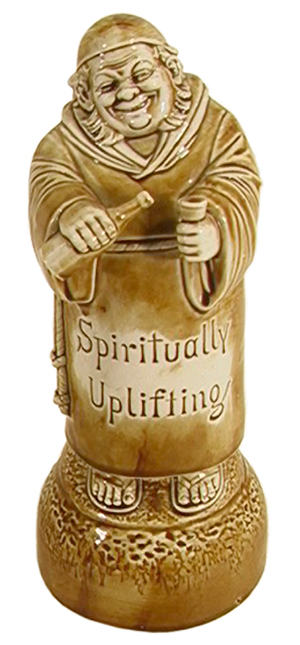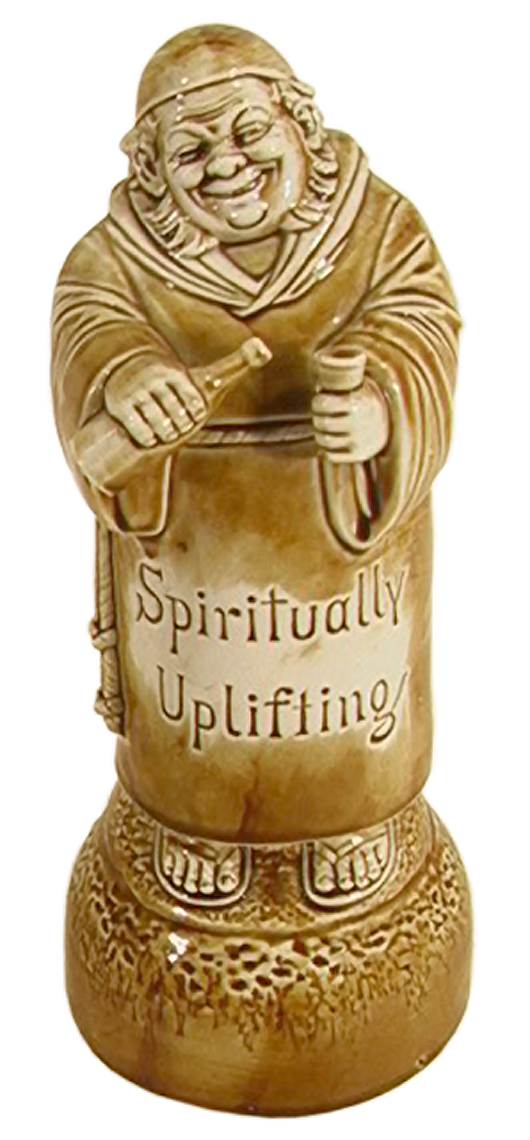
Put some fun into your collections and start hunting for old or new figurines, plates and drinking mugs that were meant to be jokes. Puzzle mugs date back to the 1700s. They were popular in taverns. When a patron was tipsy, the bartender poured ale into a mug that hid a realistic pottery frog at the bottom. Empty the mug and the frog appeared while other patrons laughed.
In the early 1800s, Chinese export porcelains were sometimes decorated with humorous or off-color subjects. One famous design is a scene of a young woman wearing a full skirt and sitting on a swing. The man next to her appears to be pushing the swing. But on the back of the plate you can see the back of the woman. Her skirt is pushed up to show her bare backside. The design was so popular that the same scene was made into a molded iron ashtray 100 years later.
Many of these jokes were connected to drinking and bars. In the 1920s, when Prohibition was the law, dozens of small bottles and flasks were made by Schafer and Vater, a German company. They were satirical, funny and risque. A disheveled drunk labeled “Prohibition,” an Uncle Sam figure holding a martini glass, a decanter shaped like a monk pouring a drink with the inscription “Spiritually Uplifting” and many other figural bottles that held whiskey were given as gifts for birthdays and holidays.
Twentieth-century joke ceramics range from dime-store “potty figures” of children sitting on potties to George Tinworth’s Royal Doulton figurines of animals acting like humans and English Martinware fantasy birds with removable heads.
Twenty-first-century jokes are easy to find and include Disney and comic-book characters. Many of the fun pieces made before 2000 now sell for high prices. But don’t ignore joke ceramics of today. They may turn out to be valuable in 50 years.
Q: I own a 24-inch-high tiger maple dresser I found in my parents’ attic. In a drawer I found a stamped mark that says, “Widdicomb Company.” On the back of the drawer someone wrote: “Trimmed July 8, 1911, Inspected August 14, 1911, Varnished August 23, 1911, Polished February 2, 1912, and Inspected February 29, 1912.” Any information would be appreciated.
A: John Widdicomb founded his company in Grand Rapids, Mich., in 1897. The company’s early work focused on interior woodwork and fireplace mantels, but it soon switched to mid-priced bedroom suites and kitchen cabinets. During the 1910s and ’20s, Widdicomb Co. made bedroom suites with matching and contrasting veneers. It continued to make furniture until 2002, when the factory in Grand Rapids closed. L. & J.G. Stickley Co. purchased the company’s remaining assets, and it continues to make Widdicomb reproductions at its factory in Manlius, N.Y. The writing on your dresser shows the steps and dates of its construction. Your dresser is a part of a bedroom suite sold in 1912. A seven-piece Widdicomb tiger maple bedroom suite recently sold for $750 at auction.
Q: We own a royal commemorative creamer and sugar that my grandparents brought to this country from Scotland in the early 1900s. We think it’s from the wedding of King Edward VII to Queen Alexandra. Both pieces are cream-colored with multicolor portraits of the king and queen. The rims are gold and wavy. Neither piece is marked. What is the set worth?
A: Queen Victoria’s oldest son, Albert “Bertie” Edward (1841-1910), was married to Denmark’s Princess Alexandra in 1863. But he didn’t become King Edward VII until Queen Victoria died in 1901. Your creamer and sugar commemorate the king’s 1901 coronation, not his 1863 wedding. If your set is in excellent condition, it could sell for about $125 to $150. It would sell for more in England than in the United States.
Q: My wife and I own a 20-inch-high kerosene lamp. The globe and mantle are made of glass, and the base is brass, copper and pewter. The handles are pewter dragons, and the base is decorated with fanciful pewter birds. The lamp is stamped, “Consolidated, Pat. Sept. 990 Apr 30 05 April 11 93.” Value?
A: The stamp indicates that your lamp was made by Consolidated Lamp and Glass Co. of Fostoria, Ohio. The company resulted from a merger of Wallace and McAfee Co. of Pittsburgh and Fostoria Shade and Lamp Co. of Fostoria. Consolidated had a reputation for making fine lamps and other lighting products. The company moved its operations to Coraopolis, Pa., after a fire badly damaged the Ohio factory. Collectors are particularly interested in Consolidated glass made after 1925, when its designers moved toward Art Deco and Lalique-inspired designs. The company temporarily closed during the Depression and closed for good in 1964. A matching pair of old Consolidated molded glass kerosene lamps recently sold for $110 at auction.
Q: Your April Fool’s Day column stated that Prince Albert tobacco, introduced in the United States in 1907, was named for the “future king of England.” But Prince Albert became King Edward VII when his mother, Queen Victoria, died in 1901.
A: Prince Albert was indeed already king when the tobacco brand was introduced here. But some tins have an added design on the front that says “Now King.”
Tip: Most ceramics can be washed with soap or detergent and water but a few things should not be. Any pieces that are repaired, damaged or have painted decorations should not be soaked in water. Wipe them with a damp cloth after testing a small area. Unglazed pieces should be dusted.
Terry Kovel answers as many questions as possible through the column. By sending a letter with a question, you give full permission for use in the column or any other Kovel forum. Names, addresses or email addresses will not be published. We cannot guarantee the return of any photograph, but if a stamped envelope is included, we will try. The volume of mail makes personal answers or appraisals impossible. Write to Kovels, Auction Central News, King Features Syndicate, 300 W. 57th St., New York, NY 10019.
CURRENT PRICES
Current prices are recorded from antiques shows, flea markets, sales and auctions throughout the United States. Prices vary in different locations because of local economic conditions.
- Walt Disney School Bus dome lunch box, metal, Mickey, Jiminy, Pluto, Donald’s nephews and more peer from windows, vacuum bottle, Disney Productions, 1960s, $40.
- Wheaties premium cereal bowl, milk glass, red silhouettes of Joe DiMaggio batting, Bob Feller pitching, other sports stars golfing and playing tennis, 1930s, $45.
- Brass gasoline-pump nozzle, working lever, made by Buckeye, dated 1926, 7 x 15 inches, $175.
- Old Soldier Tobacco pail, paper label over tin, Union Civil War soldier holding rifle, tan ground, Goodrich & Co., Milwaukee, 6 x 5 1/2 inches, $185.
- Phoenix Glass Co. vase, Wild Rose pattern, blooms and buds, coral pink wash over satin glass, 1933-36, 10 1/2 inches, $250.
- “Honey” baby doll, composition, molded blond hair, gray sleep eyes, chubby arms and legs, sheer pink dotted Swiss dress, bonnet, Acme Toy Co., circa 1928, 26 inches, $295.
- Cowan Pottery Sunbonnet Girl bookends, ivory glaze, impressed logo, 7 1/4 inches, pair, $485.
- Beatles “New Sound” toy guitar, plastic, cream and orange with four original strings, butterfly pegs, silkscreen image four Beatles, Selcol Industries, England, 1964, 23 inches, $495.
- World War II poster, “Defend Your Country, Enlist Now,” Uncle Sam has thrown down his coat and top hat, rolling up his sleeves, 38 x 25 inches, $510.
- Victorian worktable, walnut, locking drawer, sliding sewing basket, porcelain casters, signed G.E. Fuller, circa 1870, 24 x 16 x 24 inches, $1,495.
New! Contemporary, modern and mid-century ceramics made since 1950 are among the hottest collectibles today. Our special report, “Kovels’ Buyers’ Guide to Modern Ceramics: Mid-Century to Contemporary” identifies important pottery by American and European makers. Includes more than 65 factories and 70 studio artists, each with a mark and dates. Works by major makers including Claude Conover, Guido Gambone, Lucie Rie, as well as potteries like Gustavsberg, Metlox and Sascha Brastoff, are shown in color photos. Find the “sleepers” at house sales and flea markets. Special Report, 2010, 8 1/2 x 5 1/2 inches, 64 pp. Available only from Kovels. Order by phone at 800-303-1996; online at Kovels.com; or send $19.95 plus $4.95 postage and handling to Kovels, P.O. Box 22900, Beachwood, OH 44122.
3012 by Cowles Syndicate Inc.

ADDITIONAL IMAGE OF NOTE



